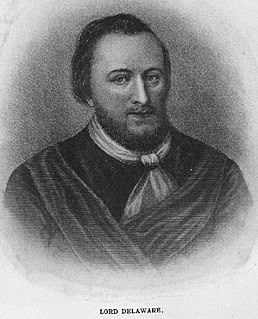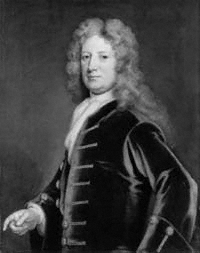Abeyance is a state of expectancy in respect of property, titles or office, when the right to them is not vested in any one person, but awaits the appearance or determination of the true owner. In law, the term abeyance can be applied only to such future estates as have not yet vested or possibly may not vest. For example, an estate is granted to A for life, with remainder to the heir of B. During B's lifetime, the remainder is in abeyance, for until the death of A it is uncertain who is B's heir. Similarly the freehold of a benefice, on the death of the incumbent, is said to be in abeyance until the next incumbent takes possession.

Thomas West, 3rd Baron De La Warr was an English politician, for whom the bay, the river, and, consequently, a Native American people and U.S. state, all later called "Delaware", were named.

Baron de Ros of Helmsley is the premier baron in the Peerage of England, created in 1288/89 for William de Ros, with precedence to 24 December 1264. Premier baron is a designation and status awarded to the holder of the most ancient extant barony of the Peerage of England. The present premier baron is Baron de Ros. Before the Dissolution of the Monasteries the Prior of the Order of St John in England was deemed premier baron.
Baron Strabolgi is a title in the Peerage of England supposedly created in 1318 for Scottish lord David of Strathbogie, 10th Earl of Atholl. Despite lack of evidence supporting its existence, it was called out of abeyance by the House of Lords in 1916. Whether it ever existed before then is open to serious dispute.
Baron Burgh is a title that has been created twice in the Peerage of England. The first creation was for William de Burgh in 1327.

Baron Hastings is a title that has been created three times. The first creation was in the Peerage of England in 1290, and is extant. The second creation was in the Peerage of England in 1299, and became extinct on the death of the first holder in c. 1314. The third creation was in the Peerage of England in 1461, and has been in abeyance since 1960.

The barony of Camoys was created twice. From 26 November 1313 to 1 April 1335 Ralph de Camoys (d.1336) was summoned to Parliament by writ, and is thereby held to have become Baron Camoys of the first creation. Ralph de Camoys (d.1336) married firstly, Margaret de Brewes, daughter of William de Brewes, 1st Lord Brewes (d.1291), and secondly, Elizabeth le Despenser, daughter of Hugh le Despenser, 1st Earl of Winchester.

Earl De La Warr is a title in the Peerage of Great Britain. It was created in 1761 for John West, 7th Baron De La Warr.

Baron Willoughby de Broke is a title in the Peerage of England. It was created by writ in 1491 for Sir Robert Willoughby, of the manor of Broke, part of Westbury, Wiltshire, who according to modern doctrine was de jure 9th Baron Latimer. On the death of his son, the two baronies fell into abeyance. Around 1535, the abeyance was naturally terminated when the second Baron's granddaughter Elizabeth, who had married Sir Fulke Greville, became the only surviving co-heir, passing her claim to her son Sir Fulke Greville, father of the poet of the same name. The title stayed in the Greville family until after the death of the 5th Baron, when it passed to his sister, Margaret Greville, the wife of a Verney. Thereafter it remained in the Verney family. The Barons Willoughby de Broke remain heirs to the ancient Barony of Latimer.

Baron Wharton is a title in the Peerage of England, originally granted by letters patent to the heirs male of the 1st Baron, which was forfeited in 1729 when the last male-line heir was declared an outlaw. The Barony was erroneously revived in 1916 by writ of summons, thanks to an 1844 decision in the House of Lords based on absence of documentation. As such, the current Barony of Wharton could more accurately be listed as a new Barony, created in 1916, with the precedence of the older Barony.
Baron Darcy de Knayth is a title in the Peerage of England. It was created in 1332 for John Darcy with remainder to his heirs general, allowing daughters to inherit.

Baron le Despencer is a title that has been created several times by writ in the Peerage of England.
Baron Fauconberg is an hereditary title created twice in the Peerage of England.
The title Baron Bergavenny was created several times in the Peerage of England and once in the Peerage of Great Britain, all but the first being baronies created by error. Abergavenny is a market town in South East Wales with a castle established by the Norman lord Hamelin de Balun c. 1087.
William West, 1st Baron De La Warr of the second creation was the elder son of Sir George West (d.1538), second son of Thomas West, 8th Baron De La Warr, by his third wife, Eleanor Copley, and Elizabeth Morton, widow of Robert Walden, and daughter of Sir Robert Morton of Lechlade, Gloucestershire. He was nephew and adopted heir of his uncle of the half blood, Thomas West, 9th Baron De La Warr, eldest son of the 8th Baron's second wife, Elizabeth Mortimer.

Thomas West, 9th Baron De La Warr and 6th Baron West, KG was the eldest son of Thomas West, 8th Baron De La Warr, by his second wife, Elizabeth Mortimer, daughter of Sir Hugh Mortimer of Martley and Kyre Wyard, Worcestershire, by Eleanor Cornwall, daughter of Sir Edmund Cornwall.
The title Baron Latimer or Latymer has been created, by the definitions of modern peerage law, four times in the Peerage of England. Of these, one was restored from abeyance in 1913; one is forfeit; the other two are dormant, although their heir is well known.

The titles Baron Montacute or Baron Montagu were created several times in the Peerage of England for members of the House of Montagu. The family name was Latinised to de Monte Acuto, meaning "from the sharp mountain"; the French form is an ancient spelling of mont aigu, with identical meaning.

Baron Willoughby of Parham was a title in the Peerage of England with two creations. The first creation was for Sir William Willoughby who was raised to the peerage under letters patent in 1547, with the remainder to his heirs male of body. An error in identifying the heir in 1680 resulted in an inadvertent novel creation by writ in 1680, without the restriction on inheritance by gender. The creation of the barony gave right to an hereditary peerage and seat in the House of Lords, the upper house of Parliament.
Baron Astley (1295) was created by writ of summons dated 23 June 1295 for a family which had lived at Astley, Warwickshire, England since the time of Henry I. Sir Thomas de Astley who was killed in the Battle of Evesham in 1265 married twice. From Sir Thomas's first marriage to Joan de Blois descended the Barons Astley.









